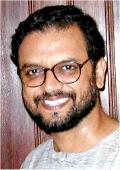
|
|
 |
| Global Perspective |
| March 29, 2005 | Vol. 2, No. 42 |

Fr. Francis Gonsalves is a Jesuit in the Gujarat Province, India. He lectures in systematic theology at Vidyajyoti College of Theology, Delhi, and has published many articles on theology, spirituality and social justice.
|
The Dancing JesuitBy Francis Gonsalves, S.J. Chenni, India -- King David danced before the Ark of the Lord with all his might (2 Sam 6:14,16), and proclaimed, "I will make merry before the Lord" (v.21). Likewise, Indian Jesuit Fr. Saju George uses India's ancient Bharatanatyam dance not only as a means of making merry before God but also as a medium of evangelization. "Dance is integral to my priesthood," says Saju mopping the sweat from a supple body that has just performed Mary's Magnificat. His magical mudras (dance gestures conveying meaning) enthrall appreciative audiences, worldwide, and give Indian worshippers a glimpse of God.
"Liturgy is sacred performance," explains Saju referring to the role of dance in Catholic liturgy. "The Eucharist is 'community worship' and the faithful assemble -- very much like the audience in a theatre -- for a communitarian God-experience. The priest is the 'main performer' who animates worship from the front." Saju feels that dance is a comprehensive form of worship: "For the dancer, it involves the mind, heart, body and soul, and for the faithful it is both, an audio as well as a visual means of encountering God." "Indian classical dances express the deep yearning of the human being (jivatma) for an experience of the Divine (Paramatma), and this experience is conveyed by expression," says Saju . Unlike Western dances that communicate messages by body movements in space, Indian classical dances narrate stories through stylized and conventional facial expressions, fingers-arms-head movements and body postures. "I spend long hours in meditation before dancing," confesses Saju , "for, unless the dance becomes a part of me and is meaningful to others, dancing is meaningless." Dance moves as 'Good News'
As an example of the efficacy of dancing in liturgy, Saju alludes to a 1999 offertory dance during the Pope's Mass in Delhi: "Based on the offertory words, 'Blessed are you, Lord God of all creation, through your goodness we have this bread/wine to offer, fruit of the earth and work of human hands,' a group of us did a dance depicting sowing, harvesting, threshing, winnowing, and finally the offering of bread." He reminisces about the tremendous impact the dance had on the faithful. Dance as dialogue among Indian religions
Saju's dancing has opened doors to the Divine and built bridges between believers of religions, especially the Hindu majority in India. "People come together through dance," says he. His dance "gurus" (teachers) include Hindus like Khagendranath Barman, C.V. Chandrashekhar and Kalanidhi Narayanan who respect the young Jesuit's bhakti (devotion) and provide him with valuable suggestions in the development of Christian dance themes. Pauline 'glory' and Ignatian 'greater glory'
Despite the fact that St. Paul uses "body terminology" to describe Christian community, Church leaders often fear the human body since dancing is susceptible to sensuality. "Such fears stem either from non-comprehension or from mental blocks," says Saju, adding, "I believe that the human body is 'temple of the Holy Spirit' and I glorify God in my body" (1 Cor 6:19-20). The Kolkata Jesuit Province to which Saju belongs is supportive of his evangelical experiments; for, when St. Ignatius spoke of "greater glory of God" in the context of "finding God in all things" he wanted his spiritual sons to sanctify every sphere of life. Surely, Ignatius rejoices that an Indian Jesuit makes merry before the Lord and translates his "Take and Receive" into dance. |
| Copyright
© 2005 The National Catholic Reporter Publishing Company, 115
E. Armour Blvd., Kansas City, MO 64111
TEL: 1-816-531-0538 FAX: 1-816-968-2280 |